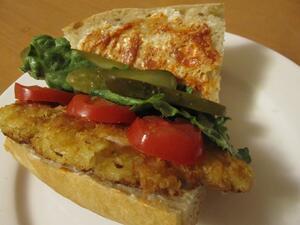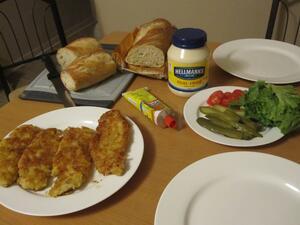Eating Jewish: Schnitzel
When you ask people to think of Israeli food, more often than not, images of crispy brown falafel will dance before their eyes. Yet, when speaking of quintessential Israeli dishes, falafel does not stand alone. Another dish that is central to the culinary landscape of Israel is schnitzel.
Its roots lie on the European continent, with Austrians coining the term schnitzel in the late eighteen hundreds to refer to pan-fried breaded meat. By the beginning of the 20th Century, central European immigrants had brought schnitzel to Israel. This dish was ideally suited to the culinary necessities of the period in Israel. At a time when few people owned ovens in their homes, these thin cutlets could be easily prepared over an open flame. After the establishment of the State of Israel in 1948 and during the period of national rationing that followed (known as the tzena), the new Ministry of Absorption taught housewives how to prepare dishes that utilized ingredients that were both inexpensive and readily available, of which one such dish was chicken or turkey schnitzel.
Schnitzel can be eaten as a meal alongside potatoes and salad (most commonly cucumber or beet), while it can also be slipped between bread or pita and eaten as a sandwich. In the April issue of Saveur magazine, David Sax, the author of Save the Deli reminisces on the time he spent in Israel in the fall of 2002. With little money to his name, he and his friend lived mainly on a diet of bottled water and schnitzel sandwiches. Not only was it a cheap way to nourish themselves, but it was also a way to connect with the others who were eating at the schnitzel shacks and provided a space to discuss topics ranging from pop culture to the future of Zionism.
Schnitzel has not only become central to the foodways of Israel, but it also played an important role in the development of Israeli identity. From being a dish that allowed Israelis to nourish themselves despite many culinary and dietary restrictions, to one that works to connect the variety of people who eat it, whether it has been sprinkled with lemon or stuffed between bread and topped with lettuce, tomatoes, pickles and harissa (or any other toppings your taste buds desire), this dish is a great way to bring a bit of Israel’s food culture to your kitchen.
Schnitzel
Adapted from Saveur’s recipe for an Israeli Schnitzel Sandwich from the April 2011 issue
4 chicken or turkey cutlets
¼ olive oil and more for frying
1 large garlic clove, finely chopped
Juice of half a large lemon, and more for sprinkling on the schnitzel when it is done
½ cup all-purpose flour
2 large eggs
2 cups breadcrumbs or panko
½ teaspoon za’atar
¼ teaspoon crushed red chili flakes, or more depending on how much heat you want
Salt and freshly ground pepper, to taste
1 French baguette
3 or 4 lettuce leaves, cut into medium sized pieces
2 or 3 small tomatoes, thinly slice
3 dill pickles, sliced
Condiments such as mayonnaise, harissa or mustard
-
Place the cutlets in plastic bags or between two sheets of plastic wrap and using a meat mallet pound the cutlets to thin them out to about ¼ inch thick.
-
Place the cutlets in a shallow dish and cover with ¼ cup olive oil, garlic clove, juice of half a lemon and freshly ground pepper. Cover the bowl with plastic wrap, place in the fridge and let marinate between 30 minutes to an hour.
-
Place flour, eggs and breadcrumbs in three separate shallow dishes, and season the flour with za’atar, crushed red chili flakes, salt and pepper. Working with one cutlet at a time, coat it in flour, making sure to shake off any excess. Following this, dip it in the eggs and finally coat with the breadcrumbs. Place cutlet on a plate and repeat with the remaining cutlets.
-
Coat the bottom of a skillet with olive oil and heat over medium-high heat. Fry the schnitzels for 2 to 3 minutes on each side, until golden brown. Drain the schnitzels on a plate lined with paper towels.
-
The schnitzels can be sprinkled with lemon juice and eaten plain along with a salad and vegetables. They can also be made into a sandwich, using the baguette, and topped with lettuce, tomatoes, pickles and any condiments of your choice.








